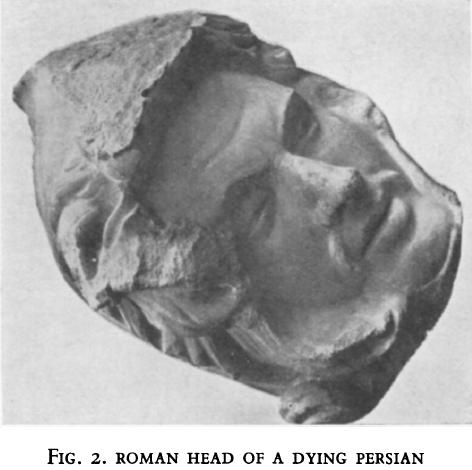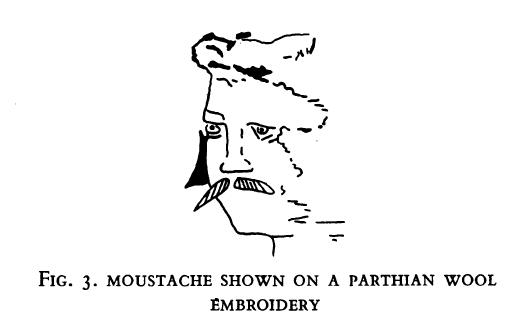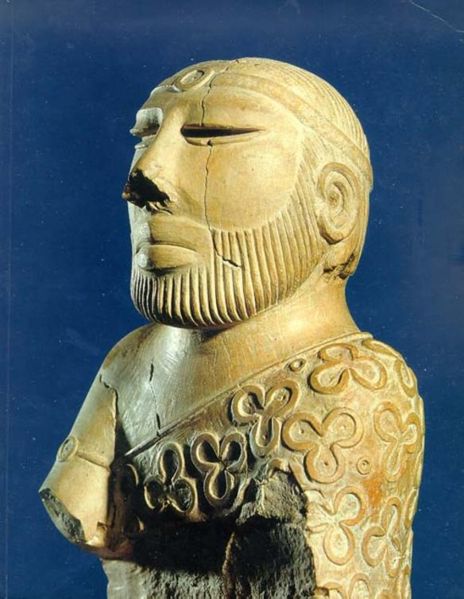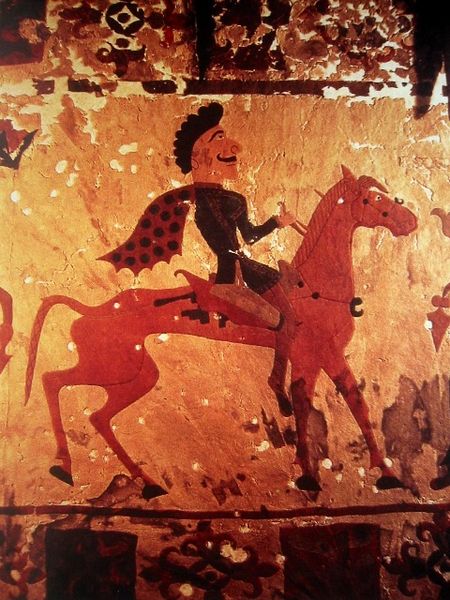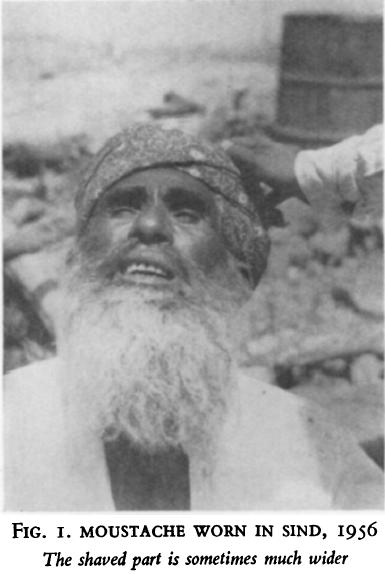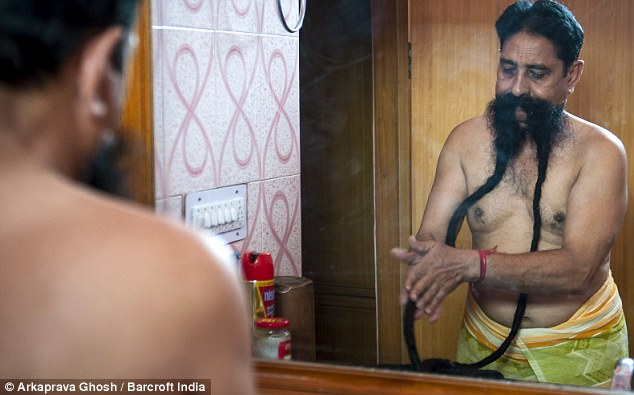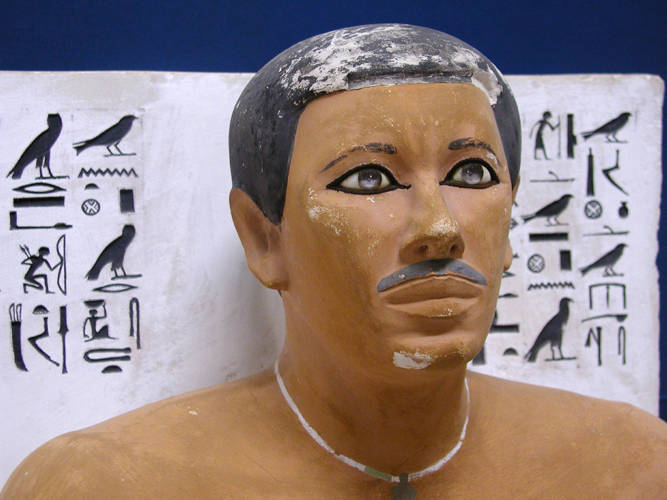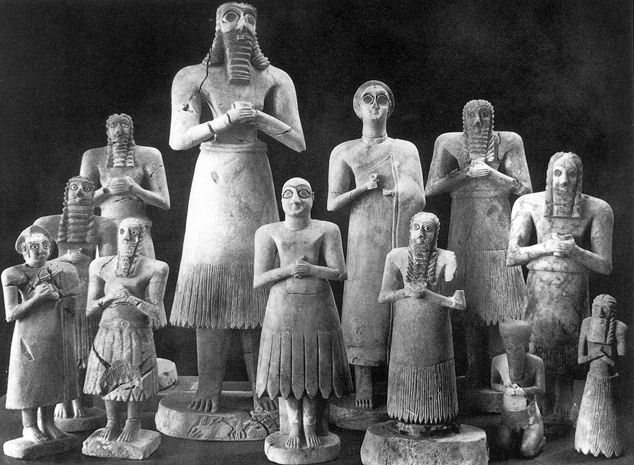The Earliest Moustache in History? February 14, 2014
Author: Beach Combing | in : Ancient , trackbackThe strangest things survive in the strangest places. Take the separated moustache of antique Persia, which is sometimes found in ancient visual representations. Heading this post is a Roman sculpture of a dying Persian and, here below, is a Parthian woolen piece that somehow survived from the first century B.C. and which is kept in the Hermitage, and which was on display as recently as the 1950s.
The men in question have moustaches but these moustaches are shaved under the nose, offering effectively two separate mini moustaches that may or may not merge with a beard. The images here and several other examples were gathered together by Lenk-Chevitch (Man 58) in 1958 with other non-illustrated instances (which were just cited). Lenk-Chevitch calls into play as a partial proof the famous Priest-King (almost certainly a misnomer), an ancient Pakistani statue from Mohenjo-daro, who is interesting in this respect. Priest-King, dating to c. 2500 BC, has a beard but a shaved upper lip, the first instance known to this blogger of artful shaving.
There has been a longstanding search for the oldest moustache, but in a sense the Priest-King trumps all these. With his unshaven face but with his shaven upper lip he has, I would argue, the first moustache: at least if we define moustache as the decoration of the upper lip by careful cutting of facial hair; in the same way that a skinhead could be said to have the first stylised hair in history.
Here, just for the record, is the usually touted earliest moustache from an Asian Steppe warrior dating to about 300 BC.
300 B.C. Pathetic! Parvenue!
Lenk-Chevitch is convinced that the two styles – shaven upper lip and shaving beneath the nose – are connected and he may be correct. But what is interesting is that Lenk-Chevitch notes how the style continued in what is today Pakistan and Afghanistan as late as 1958.
A curious way of wearing a moustache is met with among some country people of the North-Western Province, Baluchistan and Sind in West Pakistan. The moustache is cleanly shaved under the nose, often leaving some hair on the sides of the upper lip.
He offers one picture (where the man seems to be worryingly under physical constraint!) and states that the locals claim it is an old Muslim custom.
He estimates that about ten percent of the (male?) population uses the style to the north and south of Mohenjo-Daro. Where did the style come from? Well, possibly it made its way out of the Indus Valley into central Asia where the Parthians picked it up a couple of millennia before Christ.
And then we come to the really interesting question (at least for wrong time fetischists) is this moustache style still used in Pakistan or Afghanistan today? I have spent much of the morning trawling through pictures of men from Sind, Baluchistan and related regions (many of them on CIA wanted pictures….) and have failed to find examples, though I ran into some moustaches, which made Magnum PI look like a cissy.
Was Lenk-Chevitch exaggerating? Has the style simply died out? Or are my google image searches just pathetically inadequate? Drbeachcombing AT yahoo DOT com (Yes, the smart money is on the third).
14 Feb 2014: One of these posts where we advance the cause of knowledge. Invisible has pointed out that (yah boo sucks to the steppes warrior) there is a third millennia Egyptian prince portrayed with a moustache. Welcome Prince Rahotep (fl 2600-2500). Beautiful piece and so satisfying to be able to get a real moustache this early: about contemporaneous with ‘the Priest King’? Did some of the Egyptians constructing the Great Pyramid have moustaches or was it an aristocratic prerogative.
16 Feb 2014: TB writes in: …and of course the Spartans famously shaved their moustaches but not their beards , and grew their hair long, something that Hollywood has been quite unable to cope with. That admittedly hideous style seems to have become popular amongst 19c religious fanatics, like Brigham Young and his ilk. It’s also worth remarking , that despite their popularity in India and the Muslim world, moustaches are unknown in medieval Europe from the Norman period ( a few holdout Saxons perhaps ) through until the early 17c., when the beard shrinks enought to leave them on their own.
16 Feb 2014: KR writes in with this image that c. 2700 BC shows full hairy faces and is certainly cute, but does not, unless I’m looking at the wrong face, show a moustache independent of beard.
16 Feb 2014: Borky writes: “Lenk-Chevitch notes how the style continued in what is today Pakistan and Afghanistan as late as 1958.” Beach I was born in ’59 [in Liverpool] an’ some o’ the self described Pakistani landlords an’ shop keepers movin’ in t’Liverpool were definitely wearin’ versions o’ precisely that corner o’ the mouth type ‘tache right in t’the Sixties tho’ they were clearly regarded by the much taller more lordly an’ grand mannered smooth shaven Persian lamb hat wearin’ Pakistanis as lowly peasants. Pers’nally tho’ you’ve never lived till y’ve seen an’ old Chinese guy with rat’s tails danglin’ from the corners of his mouth suckin’ bright red coloured soup out o’ ’em. For some reason from childhood onwards I’ve never understood the mystique o’ tomato soup.’ thanks for this Borky!

